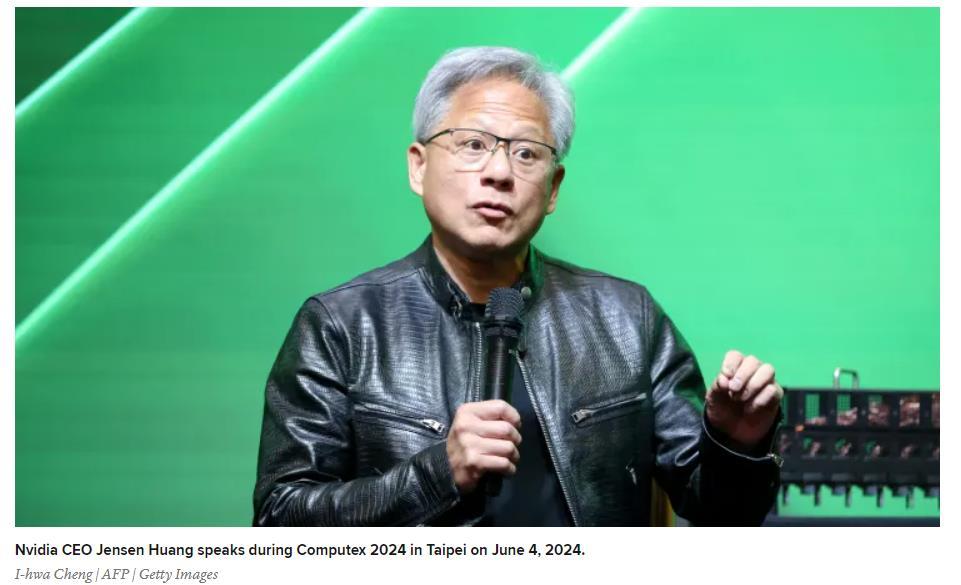Nvidia's jumps over the hurdles narrow, and earnings slow from the speed of light. That's expected to continue. Adjustment period to begin? Or dip buying?
It seems the market is adjusting to Nvidia's $NVIDIA (NVDA.US)$ jets cooling, as the pin-up stock fell 6.9% after hours despite Jensen Huang, the Godfather of AI, delivering another report that beat Bloomberg's revenue and forward guidance.
But this report seems different from the last, where Nvidia's $NVIDIA (NVDA.US)$ shares jumped 9% after hours. There are a few key reasons for this, and it could mark a narrative adjustment period that investors need to be mindful of. This means Nvidia shares could be in for a bumpy ride. And given Nvidia makes up 6% of the US market, this report could take some wind out of the market and AI's sales. However, this does not mean the overall thematic has changed.
But this report seems different from the last, where Nvidia's $NVIDIA (NVDA.US)$ shares jumped 9% after hours. There are a few key reasons for this, and it could mark a narrative adjustment period that investors need to be mindful of. This means Nvidia shares could be in for a bumpy ride. And given Nvidia makes up 6% of the US market, this report could take some wind out of the market and AI's sales. However, this does not mean the overall thematic has changed.
- Firstly, the market and investors are adjusting to the fact that earnings beats are getting smaller.
- Secondly, earnings are not growing at the speed of light anymore (+200% YoY growth) or at that earth-shattering pace. I have been saying the market saw revenue growth slowing on the horizon (2026's yearly revenue growth is only expected to be 40% vs. today’s yearly revenue annualized at 195%). But now, it seems investors might start to acknowledge that. Especially as slower growth on the horizon means Nvidia's PE is rising, making NVDA more expensive than before.
- Thirdly, Nvidia's new higher-margin Blackwell chip is experiencing some delayed gratification for investors. The earnings call didn't give the answers people wanted. What we do know is that Blackwell is expected to generate a fresh wave of growth when it rolls out in the coming months. Production of Blackwell is set to ramp up in the fourth quarter and continue into the next fiscal year. It will bring “several billion dollars” of revenue in the fourth quarter from this product. But that's not soon enough for some. AI anticipation is sky high. Investors' patience is not as strong. Nvidia has had issues with production, making improvements to its manufacturing yield (the number of chips that come out of factories). The next generation of products using Blackwell chips could help Nvidia cope with the softening growth rates.
________________________________________________________________________________________
________________________________________________________________________________________
What's next? The market adjustment period.
It's interesting that the market (Bloomberg consensus) now sees Nvidia delivering revenue growth of 76% next quarter to $31.8 billion. That's less than Nvidia's estimate provided today. The quarter after that, revenue growth of 58% is expected (Bloomberg consensus). This shows the market is expecting less growth than Nvidia sees. It's healthy to see this adjustment, so Nvidia shares might adjust accordingly.
It's interesting that the market (Bloomberg consensus) now sees Nvidia delivering revenue growth of 76% next quarter to $31.8 billion. That's less than Nvidia's estimate provided today. The quarter after that, revenue growth of 58% is expected (Bloomberg consensus). This shows the market is expecting less growth than Nvidia sees. It's healthy to see this adjustment, so Nvidia shares might adjust accordingly.
After Nvidia's results, consensus estimates remain bullish, and price targets see 16% share price growth in a year to $145.17 with 89% of analysts having the stock as a buy.
You might expect share price bumps. Remember, September is traditionally a negative period for markets, and we have end-of-quarter rebalancing and adjustments. But given the nature and magnitude of Nvidia, with 60% of clients being Nasdaq 100 companies, don't be surprised if you see seasonality play a part and perhaps dip buying. Also, remember November is traditionally the best month of the year for US stocks.
________________________________________________________________________________________
The numbers: Revenue growth is SLOWING and is expected to slow
- Revenue grew 122% YoY to $30.04 billion vs. $28.7 billion expected.
- Revenue guidance missed upper street estimates. The current quarter's revenue is expected to grow to $32.5 billion vs. $31.7 billion expected, marking growth of 80% YoY. But some analysts expected revenue to reach as high as $37.9 billion, which is a bit lofty and not in line with the market's thinking.
- I have been saying you can't expect a company to sustain sky-high growth. Before this report, we had three straight periods of year-over-year growth of over 200%.

Disclaimer: Moomoo Technologies Inc. is providing this content for information and educational use only.
Read more
Comment
Sign in to post a comment
